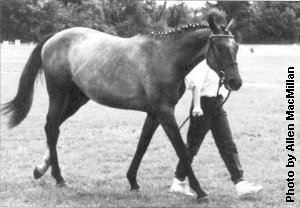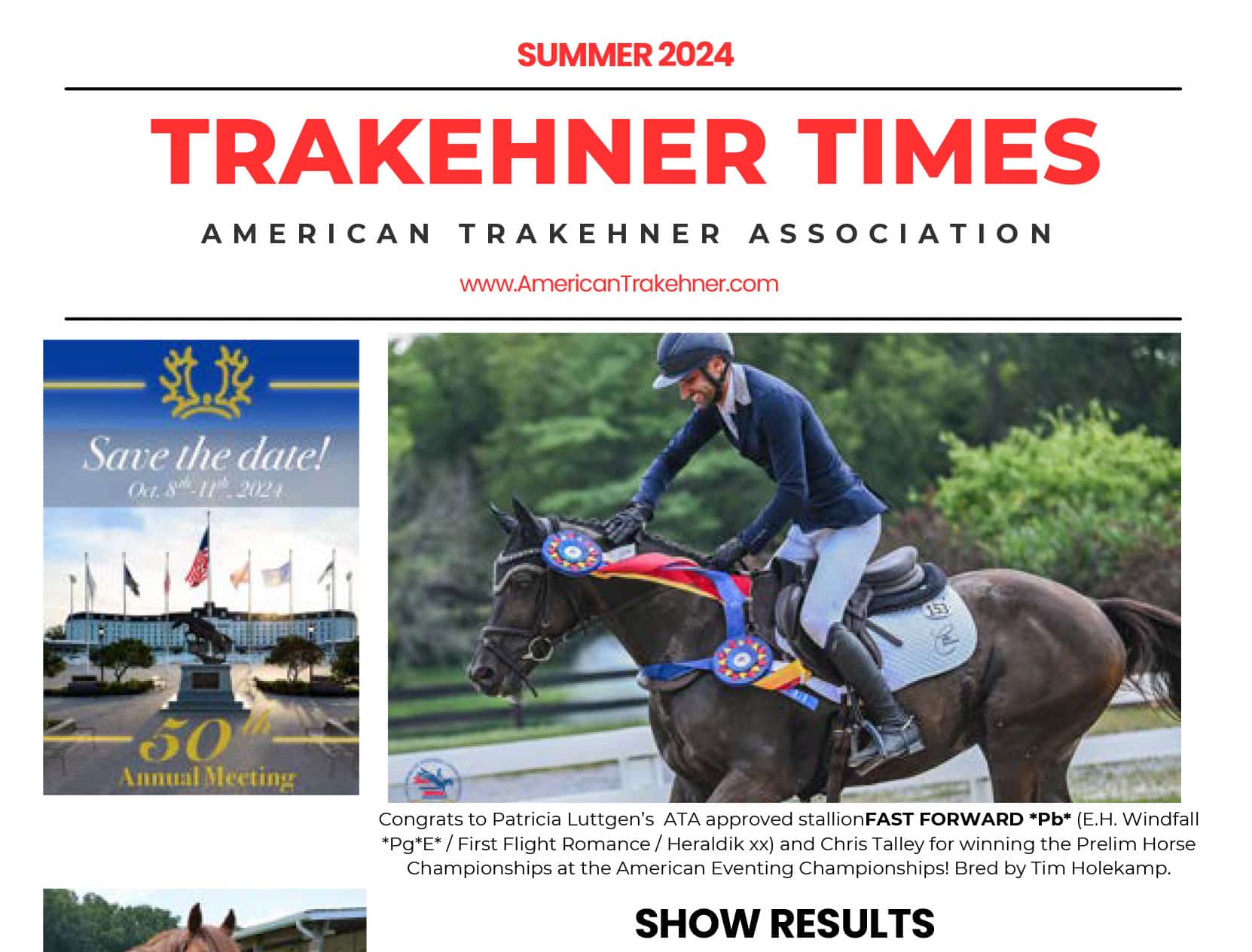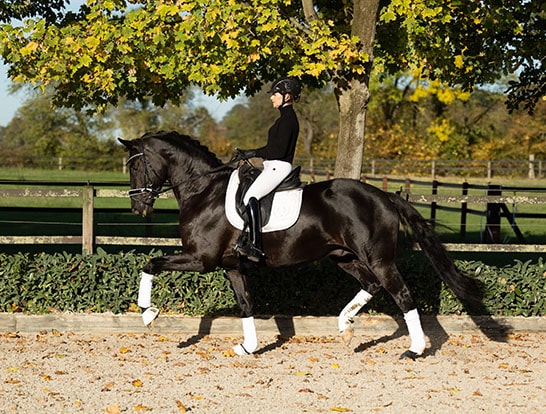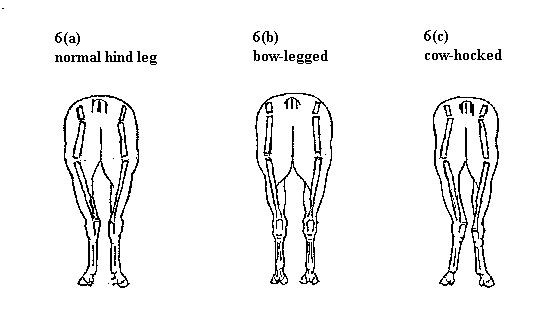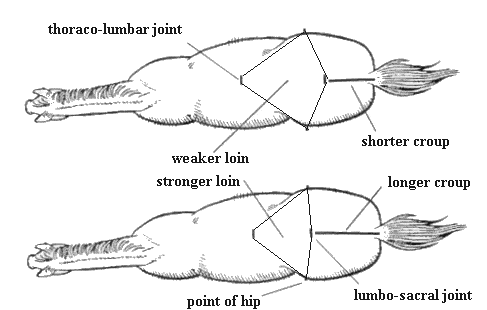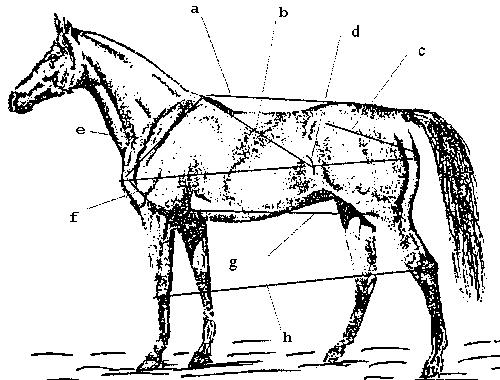by Lisabeth Willens
(Reprinted from the Winter 1996/97 – Stallion Issue)
Photos by Jamie Wilson
For 35 years the Schickedanzes’ Galten Farms has sent out a stream of performance horses that have left their mark on the sport horse world. International horses have been foaled and bred at the farm in Markham, Ontario, brilliant and unforgettable Trakehner athletes whose influence has spread throughout the competition world. Gerhard Schickedanz’s vision has driven the farm’s success and he has been joined by his daughter Charlotte in an attempt to perpetuate and refine the precious legacy he has guarded for a lifetime. Prized mare lines have been the fountainhead of Galten Farms’ success and Gerhard credits mares as the foundation of a great breeding program. He believes that stallions are nearly incidental to an old consolidated base such as the Trakehner. Gerhard learned the importance of the female to a good breeding program from his father, a successful farmer. Gerhard said his father told him, “If you don’t have the females, you have nothing.”
Mares indeed, are the foundation of Galten Farms, illustrious mares such as the amazing Abiza (by Maharadscha, out of Abendrot by Absalon), Heimische (by Gazal, out of Heimliche by Carajan) and Eshi (by Slesus, out of Macka by Wilder Jäger), a mare line which has been in the Schickedanzes’ care into its fifth generation.
The mare herd began in 1961 with the purchase of five mares from Gerda Friedrichs. These mares were the first horses that Gerda ever sold. Gerhard still has offspring from three of them, the mare Eshi’s descendants being a particular family favorite. The line continues to flourish in the present in a young spirited filly that descends from both Eshi and Amiego. She frolics in the pasture, radiating possibility. Gerhard has named her “Edith” in memory of Edith Kosterka who herself bred her approved stallion Troy from Amiego who was bred by Gerhard.
The history of the farm has its origins in East Prussia. For many generations the family had farmed and bred and traded horses, many of whom were “half-blood” Trakehners, and long familiarity ingrained the knowledge of how to cultivate and improve the horses. Gerhard Schickedanz was born in Lithuania near enough to Trakehnen to feel its influence. He emigrated to Canada in 1951.
Gerhard and his four brothers learned to be stone masons, then went into the construction business. After the family business flourished he began to develop his horse farm which now has grown to two farms. In 1960 he bought the first hundred acres of their home farm which houses some of the broodmares and the young horses. When he first purchased the land it was bare, but he set about improving it. He began planting a stand of maple trees but the maples succumbed to maple disease and dry weather. The linden trees he tried next also failed. He experimented with another variety of maple, and that time the trees flourished and now form a beautiful background. He is proud of that development because that is the farmer’s whole purpose, to leave the land better than he found it. This was another principle he learned from his father.
The home farm now consists of 200 acres and there are an additional 200 acres for farming. About 160 acres are devoted to the horses while the other acreage supports cattle and crops. There are twenty plus broodmares, more or less, and because no barns were built since 1980, the farm aims to sell 15 horses a year. The crop averages around 16, though 1996’s crop was only eight. All in all, Galten Farms has foaled close to 300 horses, some of which are very famous indeed.
Charlotte is firm in saying that breeding is a numbers game. “If we get between 16-18 foals, then, honestly, in our opinion, which may be harsher than most, we might get two or three that are above average, so it’s hard. If you’re doing it with one or two mares it’s not so easy, you may not ever get it …” Numbers alone will not do it, of course, so selecting the highest quality to achieve the desired end is essential.
Gerhard learned from his father that you must start with the absolute best or you will achieve nothing. “If your mares are above average, 55%, and you will breed them to good stallions, in your lifetime – a lifetime is four generations [of horses] – you will breed a real good one if you can bring her up from 55 to 60%. You will have done an excellent job and that is as far as you’ll go. Therefore you must have [mares that are] 75% and keep them there so they don’t go down. Don’t fuddle around with mares that are not the producing type . . . They have to come up with good foals. Each broodmare must come up with 2, 2 1/2 . . . foals that are as good as she is; then she has done her job.”
A founding member of the ATA, Gerhard Schickedanz has strong views about how the Trakehner should evolve in America. Gerhard has pursued his vision of the equine athlete, the type of horse that suited him, and has attempted in his ambitious and cutting-edge breeding program to achieve this vision. Daughter Charlotte shares his vision and is expanding into the future. Gerhard Schickedanz is working on recovering the Trakehner of his youth: the prized competitive athlete, stylish and sought after. The “chic” high-blooded Trakehner that was good at everything and was the choice competition horse.
Gerhard was greatly influenced by the late Dr. Fritz Schilke and comments, “I had quite a lot of opportunities to talk to him, feel out his views. He was like a godfather to the breed, a gentleman. He said things I wouldn’t dare to . . . He was a blessing to the breed at the time . . . [He knew the] secret to breeding: pick the ones, even those who have a little flaw that will be good for the breed, do the right thing. With him going off the scene, the Trakehner practically removed itself from top competition, other than what we had here, which were just the leftovers from his decisions, including Abdullah. I’m pretty sure if [Dr. Schilke] had been twenty years younger, the Trakehner would have been among the most internationally competitive horses, not shut out.”
Gerhard has much to thank Dr. Schilke for. Dr. Schilke not only encouraged the Trakehner Verband to accept Carajan (by Herbstwind, out of Cajenne by Trara) as a stallion (Carajan figures prominently in the pedigrees of his homebreds Amiego by Händel, out of Abiza, and Hänsel by Merkur, out of Heimische by Gazal, among others) but had also reluctantly sold Gerhard the mare Abiza. The more Dr. Schilke refused to sell Abiza, the more Gerhard wanted to buy her. “She way my kind. It’s very difficult to say, it’s like picking a woman or something like that. She just appealed to me, I wanted her. I wanted the two gray mares. The more he said they weren’t for sale, the more I liked them and the more I wanted them . . .I should have gotten them both. Fawiza and Abiza . . . [I] saw Maharadscha and I wanted them even more. He told me I couldn’t have them and wanted me to choose some others. But those just happened to be my kind, both of them, and he didn’t want to let me buy . . . Now Abiza, she had three fillies. [I told him] if you have faith in her and you think she’s such a super horse, then you have those three fillies [all by Carajan]. The other didn’t – she just had a colt. Dr. Schilke said, ‘You’re right, if she’s that good, those three fillies should show it.'” Gerhard thus acquired quite possibly the best warmblood mare in the world. Dr. Schilke, however, wasn’t upset. “He didn’t live long enough to see them perform really, but enough to see what might happen. Dr. Schilke was happy to see Abdullah here because he doubted very much whether he would have gotten the attention over there because, you see, it is one thing to have the talent and the next thing to [discover] the talent.”
Gerhard also did not expect Abdullah to be a “super horse” and credits Sue Williams of Williamsburg Farm, Middleport, NY, for bringing the talent to the forefront. “They worked so hard, [they] should have a book written about it.” Even with the success of Abiza’s offspring, the breeders over there did not know what they had and Gerhard sought out and obtained two other Abiza daughters, for one of which he paid DM 7,500 sight unseen because, “when you have a good thing, you stick with it.”
Gerhard points out the 21-year-old Archibald, Abiza’s youngest Händel son, as the offspring that most resembles his dam, especially in the rear end. Archie was small, so Gerhard gelded him. To his chagrin, Archie continued to grow, reaching 16.1 hands, but appearing much larger. A German visitor commented on Archie’s face, “The expression, the way he looks, this takes 150 years of breeding to get it that way.” Gerhard thought Archie was a better performer than Abdullah (he broke both of them to ride) but Archie was more unruly and difficult. “He could make side jumps! You don’t know how he did it. We thought we had another Grand Prix jumper coming along, but I couldn’t discipline him . . . If Sue Williams had him, perhaps more could have happened. But Abdullah and Sue, that was a one-horse affair . . . and she still rides him.”










Gerhard has bred many horses and stood many stallions. He favors breeding to Apache (by Merkur, out of Alouette (Abiza) by Tannenberg), a Prix St. Georges dressage horse, as the Trakehner stallion of the future, but places more emphasis on the mares’ contributions, “I like Apache, nice colts he is coming up [with], but some [other stallion] would come close to it.” Gerhard always returns to the importance of mares: “The important thing in breeding is the mares. The mares are your ‘A’ and your ‘Amen,’ the whole works. That’s what it depends on. The stallion, even if you have the wrong one, perhaps he can bring you down from 75% to 68-67%. As a whole, you’re still doing not all that bad. If you have 51% or 52% or 53%, you’re not going to live long enough to come [back] even to 62%, that’s where you’re condemned to be. So you’d better make sure you have something.”
“When I talk about a mare, I like to have a pedigree from a mare. I like to see what was her mother, what was her grandmother and what was her great-grandmother. I’m not so much interested in the studs . . . [With] a lot of good mothers you can’t go wrong . . . The mothers, this is important, the studs aren’t, especially in Trakehners . . .[It is] the females who have determined what has happened here on our place, and I think it is on the females that you are going to stand or fall.” The mare have to be good mares. If the first foal is a so-so foal, and if the second foal is so-so, then that is the end of the mare for breeding.
As an example, Gerhard mentions his foundation mare Abiza who produced the super horses Abdullah, Amiego, Anton, and Adrian by different stallions. “She fitted in with any stud. The studs were not that important. This is the mare to have.” “[Abiza] left so much behind her, left a whole legion behind her, we hardly have a horse which isn’t related to her, except from Händel, Merkur, and Eshi, and they’re getting thinner and thinner. She put her stamp on everything. She was like Queen Victoria . . . ” Gerhard treasures the bloodline, “a line of not only the best Trakehner mare, but what I consider the best warmblood mare, not only in North America, the best warmblood mare anywhere. There are not too many horses that come up with such a record that you have five horses go into the very top [levels of] performance .. That mare was a phenomenon, and the next one is Heimie (Heimische by Gazal). . . We have so many from them.”
Abiza’s daughter Aida (by Händel) was considered to be the limit of breedability because of her size (17 hands). Aida was bred to several stallions. Tannenberg proved too heavy so, in order to bring the offspring back into competitive range, she was bred to the Thoroughbred Always Run Lucky and, according to Charlotte, “year after year just class stuff, and then we bred her to Hänsel and came out with another good one, Aberdeen. Hänsel was okay for her, with all that Arab, but even Merkur was too heavy for her.” Charlotte says of Astrahan (Always Run Lucky xx, out of Aida), “What a horse! That is a horse that you should breed to because there’s performance there. He’s so well bred. His mother was a grand prix jumper here on our Canadian team. He has the heart and the attitude, and that means everything . . . You can compromise a little bit on some things but there are some things that you can’t, and heart is certainly one of them, when you’re breeding for higher goals . . high end competitive horses.”
Galten Farms’ goal is to breed athletes and it tests its stock in competition. The Schickedanzes insist that their horses perform. Breeding is based on the performance ability of the animals and the performers in their pedigrees without sacrificing Trakehner type. Charlotte explains the selection of conformation, “We do everything by feel and it is kind of hard to teach someone feel. You can point out certain things . . We look for depth of body and a good wither, and a short back, and a big rear end, and a good hind leg with a good angle. Dad always say, ‘look at the first step that he takes,’ you don’t even have to see him trot. How do they take the first step . . ? Their hind leg, how do they pick it up? Do they reach forward? You just develop a feel for that. It’s a lifetime education … You can never get too cocky. Always go to see what everyone else is doing .. in Europe as well. You always have to keep your eyes open and see. I always come home and say, ‘Yeah, I think we’re well on the right track.'”
Because only the best is good enough, Galten Farms operates on the edge, experimenting to bring the performance genes into the Trakehner. Charlotte says, “I want to be up there in Europe, I want to have more international performers. We’re still being true to the breed .. . Our Trakehners are more Trakehner than most Trakehners you’ll see. Because Trakehners are a type, too, and much of that type was lost . . .When you look at the expressive heads on some of the horses we have: Adrian, Apache, this the Trakehner! That’s what the old Trakehners looked like.”
Gerhard believes that the lighter Anglo-Arab base is the true Trakehner, the type known to him in his youth and developed with careful systematic inclusion of the best Thoroughbred and Arabian blood the Trakehnen stud could find. Gerhard explained the development for the current Trakehner.
“In the postwar years everyone was looking for the easier way, they fell in love with the heavier horses, the heavier warmblood, the Hanoverian, the Westphalian. They were calmer by nature. The judging became too technical and they left flair and grace out . . How does it elevate, how does it step? . . .In the last 30 years, people went over and they bought predominately heavier Trakehners, mares too, to compete against the really big ones, the Hanoverians . . .The aim was to come up with the big, big horse, big bones, a lot of big clunkers, but they don’t perform well. . .I had some of them myself. I was going in the wrong direction. Thirty years later a lot of offspring don’t look like Trakehners anymore, mares, too coarse and unathletic . . .We were mismatching . . They became too steep, they became too tall. . . They didn’t have the qualities and the conformation, not all that good.”
“I had the experience too. . . I had Sleus and he was stronger and heavier, full brother to Pregel. Then I came up with Händel, then Tannenberg, but then I took and said, ‘God!,’ and then I came to the much finer Merkur. And he rescued me, you see, and I had to go back to the finer. I had gotten too big and too coarse. The front is not right, and too many things are not right . . .There are exceptions, but not enough. I didn’t realize it was mistake, three Slesus daughters, then Händel, then Tannenberg . . yet with light horses it was fine.”
As to the future of the Trakehner internationally, Gerhard is hopeful that the reign of the heavy horse is over and the Trakehner will return to the performance horse of memory. “The judging is beginning to change from the technical, methodical, type to freestyle . . . More and more emphasis on lightness and you can see how our horses are going to show well .. . It’s changing back to what I remember in my childhood. It’s not the real heavy one, it is the considerably refined.”
Gerhard began breeding Trakehners because his early exposure to them convinced him that the Trakehner had the greatest potential to succeed in international competition. Toward this end, Gerhard has some, perhaps controversial, thoughts on the Arabian blood which has been fundamental in the success of his breeding program.
“I think we are not putting in enough, and by not putting in enough we are going to lack endurance and type, too, eventually. I have some Abiza daughters here and they look like they are Arab and they are only 1/16 Arab but the look is still there. Abiza was 1/8 Arab, look how the Arab is still in her, and Archie, her son, 21 now, still looks . . .[that way]. I bought one mare, I consider her the second best I bought, Heimische, (Hänsel’s dam), . . .I simply liked her . . .most important thing was she was half-Arab. . .This is what the breed is all about. They found a good Arab and they brought him in.” Gerhard is quick to point out this century’s marker stallions are high percentage Thoroughbred and Arabian offspring. This is what makes the Trakehner a warmblood and a warmblood of a particularly sought-after type.
Charlotte, too, appreciates the need for Arabian blood. “I can’t get enough of it, if I can get the good stuff. They’re tough, and for performance you need good tough horses not wimps that break down. You want those tougher kinds of attributes that the Arab can give. That’s why you crossbreed. I don’t think you can get a better cross than the Arab-Trakehner or the Thoroughbred-Trakehner. [For a sport horse] that’s the ultimate. A 50/50 blood cross. I can tell you with Astrahan, he has an easier time conditioning than Amiego or Anton (’92 Olympic qualifier). For him it comes easier. He’s big, heavy boned, like an English-type Thoroughbred . . not any heavier than Amiego or Anton, but he has an easier time of it.”
Galten Farms has always stood stallions for its own use. Gerhard began with Slesus, then stood Händel, then Tannenberg and finally Merkur, who changed the direction of his breeding program. Merkur was able to cross well on the heavy daughters of the other stallions and produced lighter more athletic horses. Currently Galten stands the approved stallions Apache and Bukephalos (by Insterfeuer, out of Ballyvergin Lady xx by Seminole II xx) while Hänsel and Aberdeen stand in the United States. Other stallions, such as Ethos (by Patron, out of Eterna by Markes Letzter) and Malachit (by Major, out of Marjanka by Altan), have also stood there, as did Amiego (by Handel out of Abiza). Their Bold Ruler xx grandson, Always Run Lucky xx, a cornerstone in their program, died in September 1996. His son Astrahan (out of Aida by Händel), is a current hope for international success in cross-country. The last Abiza son, Adrian (by Merkur), an Oldenburg approved stallion, also stands at the farm and is its most popular stallion. Gerhard believes the blood is too valuable to ignore.
Clearly the Schickedanzes are familiar with stallions and have handled some extremely significant ones. They recommend trying different stallions, to experiment and discover good crosses. Charlotte says, it is “a big mistake, using the same stallions over and over again. Experiment, breed a few years, move them out and try something new, otherwise you’re going to fall behind. That is if you want to choose a higher goal. Try something else . . . You don’t know unless they’ve competed and gone to high levels or were disappointing. Then go back and try something else again. It comes down to what you want to breed for and that’s individual.” The Galten Farm goal is unvaryingly international level competition and requires a different mindset than a simple riding horse program.
Charlotte refers to the difficulties the farm has in stallion selection. “After 36 years, Dad has the herd of mares that he wants, and they just keep getting better. The difficulty we’re having is finding the stallion that can help us more than the ones we already have. The male end of things is very hard, that’s why we went to a Thoroughbred. . . We couldn’t find in the Trakehner world what we needed, even in Germany. . .We haven’t found anything that would produce better for us than Hänsel or Apache or Always Run Lucky xx . . .That’s the goal: to keep going. It takes a long time to get out there.”
The last horse the Schickedanzes brought from Germany is the gray roan stallion Bukephalos. Charlotte considers him the illustration of sport horse conformation as explained by Dr. Robert Baird in his sport horse discussion. Gerhard added, “Bukephalos, his dam was an excellent performer and he competed in Intermediate level eventing, [the dam Ballyvergin Lady xx] had eight offspring that were active, racing steeplechasers in Ireland before she was sold, those were distance horses going over hard timber. That’s quality when you get sound, pounding horses like that. He was the last one we bought overseas, he was an event horse – fourth at the German championships. [He] qualified for the European championships at Burghley. I like to be as close as possible to the ones who have done something. They’ve got to do something.”
The Schickedanzes emphasize performance and have proven to the world that the Trakehner horse is capable of competing in the best classes. They have done this with animals that can be mistaken for no other kind but Trakehners and have brought fame and appreciation to the breed. Galten Farms continues to expand the gene pool of the Trakehner which Gerhard feels is narrow. The same horses’ names appear in the fifth and sixth generation in every pedigree and, by bringing in selected, tested performance blood, Gerhard hopes to widen it. Of course, the Galten program is continually under review and unsuccessful experiments are not repeated, though the knowledge is used to find better combinations. In the words of Hubertus Poll, a respected and successful Trakehner breeder, who admits that his dependence on selling horses influences what he will produce on his own farm, “What you are doing here, it is for the good of the breed. . . “
Galten Farms is carrying on the legacy of producing the ultimate performance horse of East Prussian origin with resounding success. A success built on the strength of an ideal and achieved with Gerhard’s careful priorities, “With my breeding habit, we always put great emphasis on the female end. . . I cannot see that we have gone wrong.”





